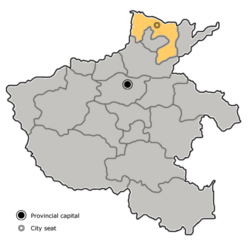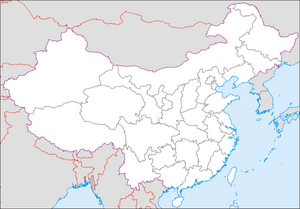Anyang
| Anyang | |
| — Prefecture-level city — | |
| Chinese transcription(s) | |
| - Chinese | 安阳 |
|---|---|
| - Pinyin | Ānyáng |
 |
|
 |
|
 Anyang
|
|
| Coordinates: | |
| Country | China |
| Province | Henan |
| Area | |
| - Total | 7,355 km² (2,839.8 sq mi) |
| Population (2002) | |
| - Total | 5,250,000 |
| - Density | 713.8/km² (1,848.7/sq mi) |
| Time zone | China Standard (UTC+8) |
| Postal Code | |
| Area code(s) | 372 |
| GDP | ¥21.35 billion (1996) |
| Major Nationalities | Han |
| County-level divisions | 9 |
| Website: http://www.anyang.gov.cn | |
Anyang (simplified Chinese: 安阳; traditional Chinese: 安陽; pinyin: Ānyáng) is a prefecture-level city in Henan province, People's Republic of China. The northernmost city in Henan, Anyang borders Puyang to the east, Hebi and Xinxiang to the south, and the provinces of Shanxi and Hebei to its west and north respectively.
Contents |
Administration
The prefecture-level city of Anyang administers 4 districts, 1 county-level city and 4 counties.
- Beiguan District (北关区)
- Wenfeng District (文峰区)
- Yindu District (殷都区)
- Long'an District (龙安区)
- Linzhou City (林州市)
- Anyang County (安阳县)
- Tangyin County (汤阴县)
- Hua County (滑县)
- Neihuang County (内黄县)
History
Xiaonanhai, on the far western edge of the city, was home to prehistoric cavemen during the Stone Age. Over 7,000 artifacts (including stone tools and animal bone fossils) have been unearthed here representing what has been dubbed the Xiaonanhai culture.[1]
Around 2000 BC the legendary sage-kings Zhuanxu and Emperor Ku are said to have established their capitals in the area around Anyang from where they ruled their kingdom. Their mausoleums are today situated in Sanyang village south of Neihuang County.[1]
At the beginning of the 14th century BC King Pangeng of the Shang Dynasty established his capital 2km north of the modern city on the banks of the Huan River. The city, known as Yin, was the first stable capital in Chinese history and from that point on the dynasty that founded it would become known as the Yin Dynasty.
The capital served 12 kings in 8 generations, including Wu Ding under whom the dynasty reached the zenith of its power, until it was wiped out along with the dynasty that founded it by King Wu of the Zhou Dynasty in BC 1046.
Anyang's Tangyin County was the seat of Yue Village, birth place of the famous Song Dynasty General Yue Fei. This was also the historic home of Zhou Tong, yue's military arts tutor (though fictional sources place him in Shaanxi).
The contemporary Anyang was constructed in 1368 AD during the Ming Dynasty.
Economy
Anyang's opening to the outside world has enabled its foreign economic relations and trade progress rapidly. Sixteen foreign-funded enterprises (joint ventures, cooperative enterprises and wholly foreign-owned enterprises) have been established. Recently, Anyang has established an economic and technological development zone covering a total area of 22.8 square kilometers and issued a series of preferential policies to attract many domestic Chinese and foreign businesses. A multichannel, all-round foreign relations and trade network have been set up to lay a foundation for developing Anyang's economy.
Tourism
Anyang City is an ancient city with a history of over 3,000 years and is one of the Eight Ancient Capitals of China. It is one of the key birthplaces of Chinese ancient culture. Here are the primitive caves of 25,000 years ago, the overlapping stratums of the Yangshao Culture, Longshan Culture and Xiaotun Culture, the memorial mausoleums of ancient Emperor Zhuanxu and Emperor Ku over 4,000 years ago, the first library of inscriptions on bones and tortoise shells, the Soul Spring Temple known as the "First Ancient Buddhist Temple in Henan", and 10,000-Buddha Ravine, as well as unique Wenfeng Pagoda, Xiuding Temple Pagoda and Mingfu Temple Pagoda. Anyang also has beautiful natural scenery -- the Taihang Linlu Hill Scenic Area on the 400-kilometer Taihang Mountains and the grand 1,500-kilometer Red Flag Canal.
Tianning Temple
Tianning Si (Mansion Temple) was established during the Zhou dynasty and has recently been restored by the Protection and Research Institute of Ancient Architecture of Anyang City and opened to the public. Main structures within the temple compound include; the gate house, the 3 room (8.4m x 14m) Hall of the Heavenly King with hanging-eaves over the gables rebuilt in 2002,[2] the slightly larger (17.8m x 11.65m) Precious Hall of the Great Hero with single-eave gabled roof originally from the Qing dynasty and rebuilt in 2001,[3] and the Wenfeng Pagoda.
Wenfeng Pagoda
Wenfeng Ta (Literature Peak Pagoda) on the grounds of the Tianning Temple is believed to have been constructed in 925 and is known, from inscriptions concerning the reconstruction of the temple, to have been in place by 952. The current pagoda was constructed during the Ming Dynasty and got its current name during the Qing Dynasty due to its proximity to the Confucian temple. The five-story dark red brick octagonal tower is 38.65m high and unusually is larger at the top than the bottom and is topped with a 10m Lamaist stupa-style dagoba steeple. The pagoda stands on two-metre-high stone pedestal and is decorated with multi-eave pent roofs and carvings of Buddhas and bodhisattvas. The unique pagoda is the symbol of Anyang.[1]
Yinxu Museum
Located about 2 km northwest of Anyang are the ruins of the Shang Dynasty capital known as Yin. This massive archaeological site was discovered in 1899, excavated in the decades that followed and first opened to the public in the 1980s as the Garden Museum of Yinxu. The current museum was opened on 16 March 2005 and includes the famous Tomb of Fu Hao. The site is inscribed on the UNESCO list of World Heritage Sites.
Sister cities
See also
- Historical capitals of China
- Yinxu
Notes
- ↑ 1.0 1.1 1.2 "Anyang Tour Guide". chinahotelsreservation.com. Retrieved on August 4, 2007.
- ↑ "Hall of the Heavenly King", Tianning Temple. "The Hall, an architecture of hanging-eaves over the gables, has a space of 3 rooms with a length of 14m, a width of 8.4m and a height of 9.6m. It was designed and rebuilt on the site by the Protection and Research Institute of Ancient Architecture of Anyang City in 2002."
- ↑ "Precious Hall of the Great Hero", Tianning Temple. "The Precious Hall of the Great Hero, Tianning Temple, The Precious Hall of the Great Hero, as architecture of single-eave and gabled roof, is 11.65 meters’ long and 17.8 meters’ wide. Rebuilt in the 25th year of Qianlong in Qing Dynasty. Thoroughly restored by the Protection and Research Institute of Ancient Architecture of Anyang City in 2001."
External links
- Government website of Anyang (in Simplified Chinese)
- Visit Anyang
|
||||||||||||||||||
